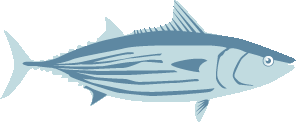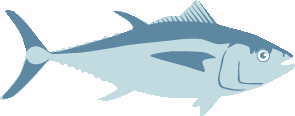Overview
Tropical tuna purse seine fishery in the Eastern Atlantic targeting yellowfin, skipjack and bigeye tuna. This area is under the mandate of the International Commission for the Conservation of Atlantic Tunas (ICCAT), the regional tuna fisheries management organisation (RFMO) in the Atlantic Ocean. This FIP is a multi-stakeholder effort, and it's goal is to support improvement in the management of tuna fisheries in the Eastern Atlantic Ocean so that in the future, consumers can be assured that the purse-seine tuna they purchase has been harvested sustainably. The ultimate aim is to meet the highest standards of sustainable fishing, such as the Marine Stewardship Council (MSC) standard.
Target species: this FIP will consider the following three pelagic tuna species as the target species: skipjack tuna (Katsuwonus pelamis), yellowfin tuna (Thunnus albacares) and bigeye tuna (Thunnus obesus).
Fishing methods: this FIP will include the use of purse seines by large (e.g. >60 m) specialist purse seine vessels. Set by these vessels can be made in two different ways: 1. Free-schools: vessels seek (sometimes with the assistance of helicopters) large schools of tuna which are usually fished during daylight. 2. Associated sets: vessels that utilise the natural aggregation of tuna around floating objects to harvest fish. These floating objects can include natural logs (and other large debris), large marine animals such as whale sharks, and around purpose-built drifting FADs.
Fishing area: the fishing area is the Eastern Atlantic Ocean under the jurisdiction of the International Commission for the Conservation of Atlantic Tunas (ICCAT) e.g. FAO Statistical Areas 34 and 47 including the high seas and tuna fishing zones of Coastal States' waters within these areas.
Fishing fleet: the fishing fleet to be covered by this FIP currently consists of industrial purse seine fishing vessels operating in the Eastern Atlantic Ocean and varying in length from around 50m to 100m.
Note: Currently, Fisheryprogress.org can only track MSC Performance Indicator (PI) Scores for one target species at a time. In the case of this FIP, which encompasses three different types of tuna, PIs will be tracked for the species that is most threatened within the fishery.
The Eastern Atlantic tropical tuna Ghana purse seine fishery improvement project targets Atlantic Ocean bigeye (Thunnus obesus), eastern Atlantic Ocean skipjack (Katsuwonus pelamis), and Atlantic Ocean yellowfin tuna (T. albacares) stocks on the Atlantic Ocean high seas and the Exclusive Economic Zones (EEZs) of Ghana, Côte d’Ivoire, Sierra Leone, Liberia, Benin. The fishery sets on both free-school tuna or schools associated with floating objects (FOBs) either naturally occurring such as logs or artificial drifting fish aggregation devices (FADs). All vessels in the fishery are flagged to Ghana and are owned by owned by the fishing companies within the Ghana Tuna Association (GTA). The vessels land in Tema (Ghana). The fishery is managed regionally by the International Commission for the Conservation of Atlantic Tunas (ICCAT) and the Ghana’s Fisheries Act (2002) through the Ghana Fisheries Commission (GFC). The fishing companies have further management measures in place and coastal states management measures also apply depending on where the vessels are operating.
The FIP was originally comprised of vessels flagged to Ghana, France and Spain however as the vessels are under different management measures, the fleets have progressed at different rates whilst working towards achieving MSC certification. To this end, the FIP participants made the decision to divide the FIP into its different components. This FIP will now report on the progress of the Eastern Atlantic Ocean Tropical Tuna Ghana Purse Seine fishery.
Tropical tuna purse seine fishery in the Eastern Atlantic targeting yellowfin, skipjack and bigeye tuna.
- To form a collaboration between governments, industry and fleets to bring about improvements in the fishery.
- To address the shortfalls in the stock health, ecosystem health and management of the fishery by meeting actions described by the Improvement Performance Goals (IPGs).
- To improve the fishery to a point at which it can undergo (and pass) full assessment by a credible, science-based, multi-stakeholder certification programme like the MSC by the end of 2028.
FIP at a Glance
| 11% | 68% | 21% |
This pie chart represents completed environmental actions. Non-completed environmental actions may contain completed sub-tasks that are not illustrated here. For more information on environmental action progress visit the Actions Progress tab.
- Complete
- Incomplete



